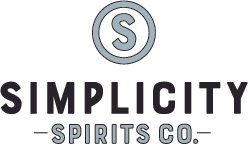Industry Terminology 101
a basic intro
Simplicity’s School of Alcohol Aficionados & Cocktail Connoisseurs is now in session. ;)
Grab a drink and take some mental notes.
BEER vs. wine vs. liquor
Let’s talk about the timeless trifecta of the booze industry — beer, wine, and liquor. All three rely upon the process of fermentation to produce ethanol, the “feel good” molecule in alcoholic drinks. The basic difference is the raw product which is fermented to get the ethanol alcohol. While beer is fermented with malted barley and other grains, wine is derived from fermented grapes. Liquor is made by distilling (repeatedly heating/cooling/purifying) already fermented grain, vegetable, or fruit-based alcoholic liquids to produce a more potent spirit (vodka, gin, tequila, whiskey, etc).
These unique alcoholic bases and processes of fermentation and distillation result in differing levels of alcohol by volume, or ABV. On average, the standard drink contains:
12 oz of beer at 5% ABV
5 oz of wine at 12% ABV
1.5 oz of liquor at 40% ABV
1 Simplicity Cocktail with 100% chance of a good time :)
Hard seltzer vs. vodka soda
There is a common misperception that hard seltzer is synonymous with vodka soda. You may be surprised to hear that most hard seltzers on the market do not contain vodka or any other distilled spirit. The “spiked” aspect of seltzer comes from the fermentation of sugar and yeast via malted grains. As a result, most popular hard seltzers are considered “malt beverages” swinging in at around 4-5% ABV. According to Utah’s alcohol laws, these malt-based hard seltzers (think White Claw) can be sold in gas stations and supermarkets in the beer section. Millennials and Instagrammers in Utah, rejoice! Ain’t no (liquor) laws when you’re drinking claws! However, ain’t no real vodka or distilled spirits either.
On the flip side, a vodka soda is a simple drink containing (you guessed it!) real vodka mixed with soda water and oftentimes additional flavors. Here at Simplicity, we craft our Vodka Soda using premium potato spirits and natural lime flavor.
Photo by The Spruce Eats
Spirit vs. liquor vs. liqueur
Liquor and Spirits are essentially synonymous. Unsweetened, pure, and distilled hard alcohol at or above 40% ABV, fueling the spectrum of celebratory parties and ill-fated drinking contests alike. Mash around a couple letters in liquor and you get liqueur, a sweeter variation of the drink with new flavors, oils, and extracts added. Whether you’re mixing coffee with Kahlua or splashing Triple Sec into a Margarita, liqueurs allow for creative and specialized drinks. Despite the additive nature of liqueurs, these products are still considered liquor. Confused yet? Let’s make sense of flavors, extracts, and essences.
Flavor vs. extract vs. essence
The standalone term “flavor” or “flavorings” on alcoholic beverage labels can mean artificial or natural flavors, but it usually refers to artificial origins. Including the term “natural flavor(ings)” on a label should mean that the flavor is made from natural substances only. Extracts are created by placing a raw material into a combination of alcohol and water to extract elements from the raw material into liquid form. For example, vanilla beans undergo this process to extract raw elements and produce common ‘vanilla extract’. Extracts are clear, highly concentrated, and high-heat stable liquids with an alcohol and/or water base only. Lastly, essence refers to the inexpensive ‘culinary strength’ flavorings that can be added to a neutral spirit to give it a desired flavor without waiting for the spirit to age.
GNS (Grain Neutral Spirits)
Grain Neutral Spirits, known as the “holy ghost” of the booze world, refer to alcoholic products distilled from anything or a mix of things — typically bases such as corn and sugarcane due to their rock-bottom prices. Think maximum efficiency (high ABV) and total flavorlessness. As the name implies, these spirits are neutral in color, flavor, and odor making them an ideal culprit for ‘cutting’ liqueurs and creating bitters. GNS has even branched into the pharmaceutical, perfumery, and cosmetics industry due to denaturing agents. However, if you’re on a budget, want to reminisce on booze-fueled shenanigans of early adulthood, or prefer tasteless marketing stories that take the form of vodka, GNS-based products will surely get the job done!
rtd (ready-to-drink)
RTD beverages, including our entire lineup of Simplicity Cocktails, are crafted and packaged to be ready for immediate enjoyment. Forget the glass liquor bottles, additional mixers, and garnishes required to craft your favorite cocktail. Our RTD cocktails are designed to be indulged straight out of the can to simplify your active lifestyle and provide you with convenient, functional, and portable drinks to pair with any adventure. Head over to our Cans vs. Glass blog post to learn more about the benefits of canned cocktails.
Any questions? Let us know in the comments below.
Don’t forget to sign up for our email newsletter for the latest updates on cocktails, upcoming events, and The Lab — our new headquarters with some epic projects in progress!








